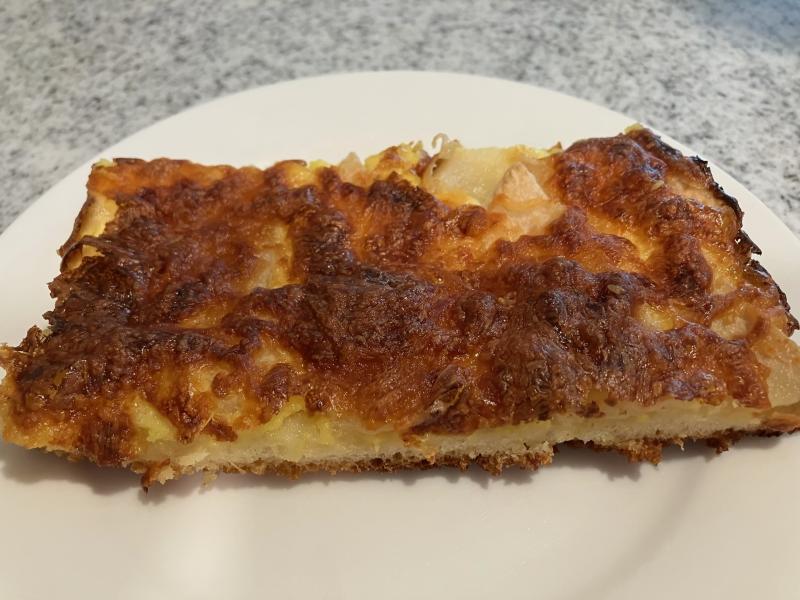Mascarpone cheese adds an elegant touch to many dishes
My neighbors here at the Lodge have organized a weekly potluck dinner for Sunday afternoons at five. Everyone brings something to share – a bottle of wine, homemade mac and cheese, blueberry tart, steamed shrimp, a charcuterie platter – you can never predict what will be on the table, and there are rarely any leftovers.
Through the weeks, I’ve tried different things, but last week, I brought a taste of autumn with a pear and mascarpone pizza. In the photo, the top layer of mozzarella has browned quite a bit and may look like tomato sauce, but the inner layers of thinly sliced pears and creamy mascarpone cheese were the perfect companions to a simple pizza crust.
The reason I chose mascarpone is its unique texture and taste. This soft, white Italian cheese originated in the Lombardy region of northern Italy near the border with Switzerland. The area is dotted with large lakes, rolling hillsides and lush valleys that offer rich pastures and an ideal climate for grazing cows. Food historians believe mascarpone was first produced during the late 1500s when farmers found a delicious use for their leftover cream.
Its name comes from the local word for ricotta, mascarpia, as both cheeses are made in a similar fashion. Mascarpone is made from heavy cream, sometimes called double cream, to which a form of acid is added (lemon juice, citric acid or cream of tartar). As it is heated, the mixture separates and the excess moisture or whey is drained off through a cheesecloth, leaving fresh, soft, spreadable cheese.
With a fat content of over 60 percent, you will find the texture luxurious, somewhere between cream and butter. Its flavor is mild, but just as butter can elevate a recipe, so too can the addition of mascarpone cheese. Most famously, mascarpone is found in the classic Italian layered dessert tiramisu as well as in the filling for cannoli. Some inventive chefs will add it as a topping for pasta or a warm, thick soup.
It’s often compared to American cream cheese, but the key difference is that cream cheese is made from whole milk, while cream-based mascarpone has a silkier, smoother mouthfeel. That said, you can certainly take liberties by substituting mascarpone for creme fraiche, ricotta or sour cream. You may discover that you prefer the substitute to the original.
Another way to enjoy mascarpone is to stir a spoonful into scrambled eggs or mashed potatoes for a subtle improvement to the texture. In the mac and cheese recipe below, mascarpone is the basis of the sauce, instead of mixing together a roux from flour and butter. The other advantage is the use of only one stovetop pan, which makes cleaning up easier. The chicken recipe is a variation of chicken Marsala that is enhanced by the use of mascarpone to create a rich sauce.
You can find mascarpone in 8-ounce and 16-ounce plastic tubs in the specialty cheese section at your grocery store. If you’re looking for a traditional recipe, the internet has all sorts of instructions for assembling tiramisu, which is made from coffee-soaked lady fingers layered with mascarpone filling and dusted with cocoa. Perhaps I’ll try it for our next potluck.
Pear Pizza
Preheat oven to 400 F. Stretch the pizza crust onto a baking pan, leaving a slight upturn around the edges. Whisk together mascarpone and lemon juice. Spread on unbaked pizza crust. Peel, core and thinly slice the pears; arrange to completely cover the cheese, overlapping slightly. Sprinkle with mozzarella. Bake until golden, about 25 minutes.
Mascarpone Mac & Cheese
Chicken Marsala
Cut the chicken into uniform strips about 1/2-inch wide. Sprinkle generously with salt and pepper. Heat oil in a large skillet over high. Add chicken and cook until lightly browned, about 4 minutes. Remove chicken to a plate and tent with foil. Reduce heat to medium and add butter. Add onion and cook until translucent, about 3 minutes. Add mushrooms and garlic; cook until liquid evaporates, about 10 minutes. Add the marsala and simmer until reduced by half, about 4 minutes. Stir in the mascarpone and mustard. Return the chicken and any accumulated juices to the skillet. Simmer, uncovered, over medium-low heat until the chicken is just cooked through and the sauce thickens slightly, about 2 minutes. Season the sauce to taste with salt and pepper; garnish with parsley. Serve over boiled and drained pasta. Yield: 4 servings.





















































